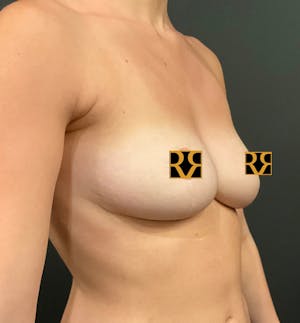Breast augmentation continues to be the most common plastic surgery procedure in the U.S. Because of this, the frequency of patients that decide to revise their breast augmentation is also common.
This patient had undergone a breast augmentation and breast lift by another surgeon. Unfortunately the result was not what the patient wanted including the implants 'bottoming out' where they sit below the breast fold, poor breast lift incision scars, and breast implant size that was too wide for her chest width. To correct these issues we performed a breast revision with narrower implants, a pocket repair also known as a capsulorrhaphy, and a breast lift revision. She is shown here six months after her surgery.
This patient had undergone a breast augmentation and breast lift by another surgeon. Unfortunately the result was not what the patient wanted including the implants 'bottoming out' where they sit below the breast fold, poor breast lift incision scars, and breast implant size that was too wide for her chest width. To correct these issues we performed a breast revision with narrower implants, a pocket repair also known as a capsulorrhaphy, and a breast lift revision. She is shown here six months after her surgery.
This patient had undergone a breast augmentation and breast lift by another surgeon. Unfortunately the result was not what the patient wanted including the implants 'bottoming out' where they sit below the breast fold, poor breast lift incision scars, and breast implant size that was too wide for her chest width. To correct these issues we performed a breast revision with narrower implants, a pocket repair also known as a capsulorrhaphy, and a breast lift revision. She is shown here six months after her surgery.















